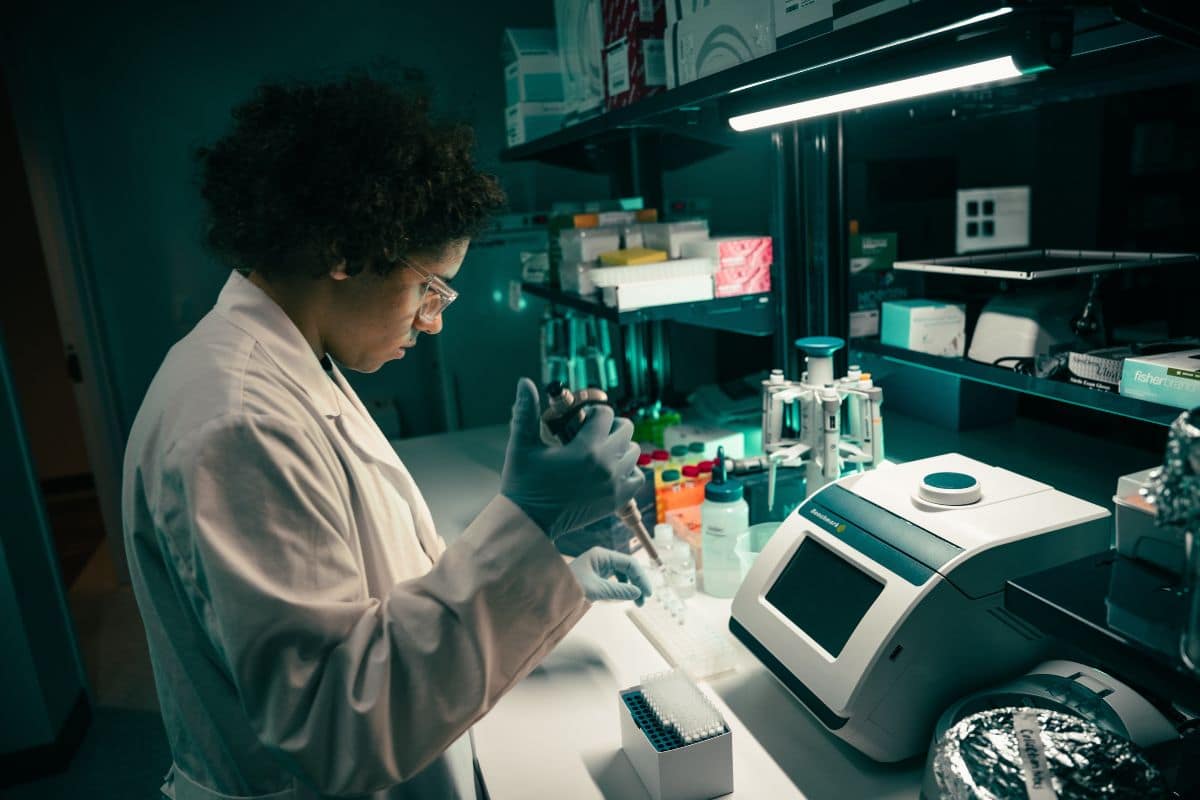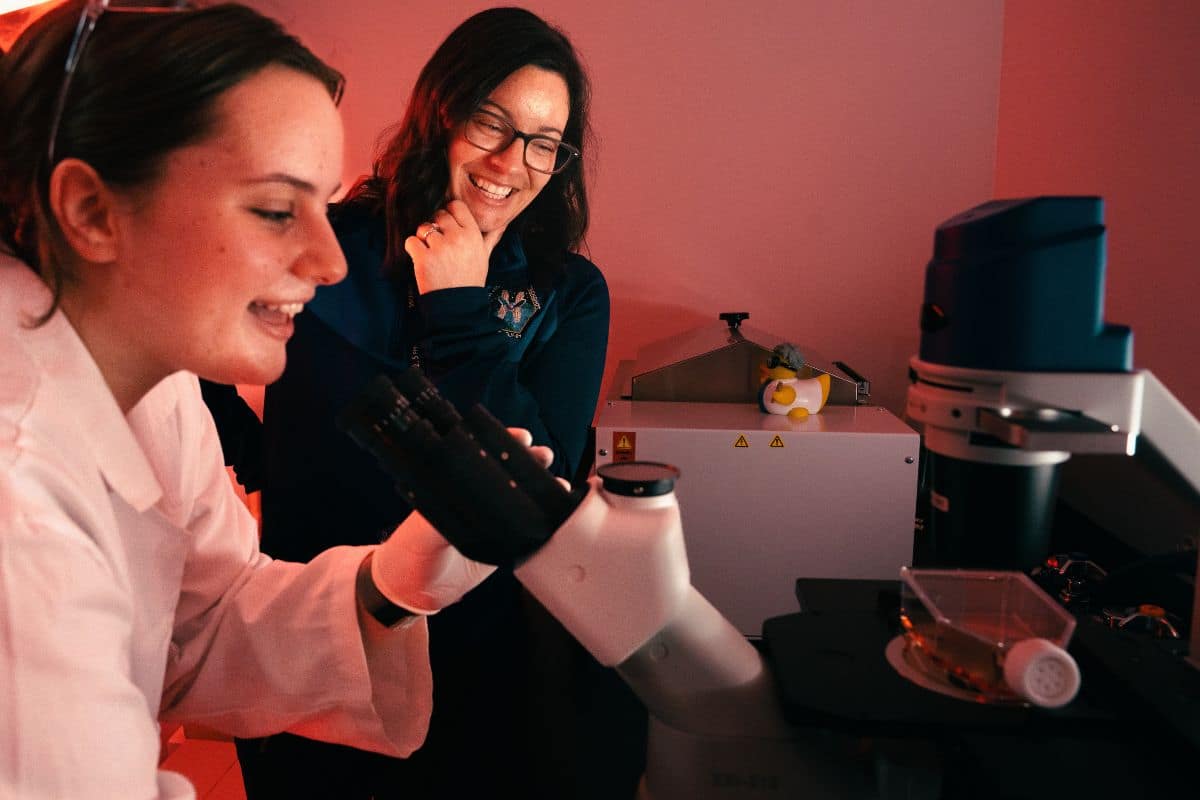

Omics Lab is a Hub for Aerospace Physiology Exploration

Omics Lab for Health and Human Performance
Boldly going where no one has gone before takes more than just a mastery of space travel. It also takes the knowledge that can help humans stay healthy once they leave the planet.
That is among the many goals of the unique Omics Lab for Health and Human Performance at Embry‑Riddle Aeronautical University. The lab, located in the College of Arts & Sciences building, gives student researchers interested in Aerospace Physiology the chance to conduct analysis on various organisms, including humans.
In biology, omics refers to the global evaluation of a cell through multiple disciplines, including genomics, epigenomics, transcriptomics, proteomics, and metabolomics. In addition, cellular and molecular pathways and processes that govern cellular functions are also important areas of research.
The Omics Lab offers many molecular- and cellular-based research opportunities for students and collaborators focused on life sciences in extreme environments.
Dr. Amber Paul, is a Embry‑Riddle Wessel endowed assistant professor of Aerospace Physiology in the Department of Human Factors and Behavioral Neurobiology, and director of the facility. She previously was a NASA postdoctoral Space Biology Program fellow at NASA Ames Research Center and her current research is in part supported by NASA Human Research Program Human Factors and Behavioral Performance Element.
Dr. Paul took time out to discuss the lab and the unparalleled opportunities it offers students to take part on groundbreaking space-related discoveries.
Why does the Embry‑Riddle Omics Lab study life in space?
The extreme environment of aerospace can induce physiological stress in animals. My research interests include understanding how the physiological stress response influences the mammalian immune system, as there are some fascinating integrations between endocrine stress hormones and immune cells when exposed to chronic physiological stressors. Considering not only the type, but the timeframe (acute verses chronic) of physiological stress that influences immune dysregulation, is a primary interest of mine.
What opportunities does the lab provide prospective students?
The Omics Lab utilizes many molecular-based tools to address life science questions. This is the first time Embry‑Riddle has housed a biosafety level II cell culture facility to address these types of questions.
Further, extension of techniques with next generation sequencing enhances the student experience, as the Omics Lab houses state-of-the-art instruments, including an Illumina NextSeq1000. Similar to life science- and clinical-focused universities, students in the Omics Lab are exposed to molecular and cellular techniques that can provide an advantage for career development in study of life sciences.
My lab also participates in collaborations and NASA-funded projects, including spaceflight and ground studies, which provides extraordinary opportunities for student involvement. We also engage with facilities at NASA centers for experimental- and tour-based purposes, which are prime sites for student involvement in aerospace-related life sciences research. In addition, we utilize open science data repositories, such as NASA Open Science for Life in Space and NASA GeneLab to educate students on how to process and perform bioinformatics on life sciences samples exposed to spaceflight environments.


Which students would benefit most from working in the lab and why?
Students focused on life sciences, including students interested in biomedical design and bioinformatics. As part of the Aerospace Physiology program, with efforts to expand into engineering, physical, and data sciences realms, students currently within these areas of sciences would benefit from the Omics Lab.
Aside from development of molecular and cellular techniques, there are many opportunities for project advancement that include bioengineering, such as 3D tissue chip designs, biometrics monitoring, and analysis of large-scale biological datasets generated from the sequencing power in the Omics Lab.
What are examples of careers students could pursue with their lab experience?
Cellular and molecular techniques learned in the Omics Lab are universal within clinical, academic and government research labs that focus on life sciences. Techniques such as genetic isolation, purification, and sequencing, cell culture aseptic methods, and flow cytometric analysis, to name a few.
All of them are valuable practices that are applicable in many research-based programs, facilities, and industries involved in biological and molecular sciences.
How does the lab prepare students for success?
Aside from research techniques, which are valuable for career development, students have the opportunity to participate in project-focused research, enabling critical thinking skills and generation of scientific hypotheses to carry out research queries.
Further, participation in conferences and symposiums to expand communication and presentation skills, as well as social networking, are also in part of the student experience. In addition, based on the level of involvement in research, peer-reviewed scientific publications are possible deliverables for student career development success in the Omics Lab.
What are some practical applications for Omics Lab research?
Aside from scientific research, the opportunities to learn important techniques and instrumentation capabilities are also a practical application in the lab.
For example, one student is currently designing fluidics and optical settings that are involved with the flow cytometer instrument with a career goal of engineering a more user-friendly instrument. Similar directives for next-generation sequencing and bioinformatics learning are also possible.
Why is the Omics Lab important to Embry‑Riddle?
The Omics Lab diversifies the university’s expansion into life sciences with a focus in aerospace and aeronautics. Opportunities in the Omics Lab for student involvement in biological research bridge the gap between aerospace and terrestrial life sciences.
Recent students who have been part of the Omics Lab are currently government contractors, enrolled in medical school or academic graduate studies and research institutions, and are interning within aerospace companies and government contractor positions, enabling development of next generation space (and terrestrial) biologists.

